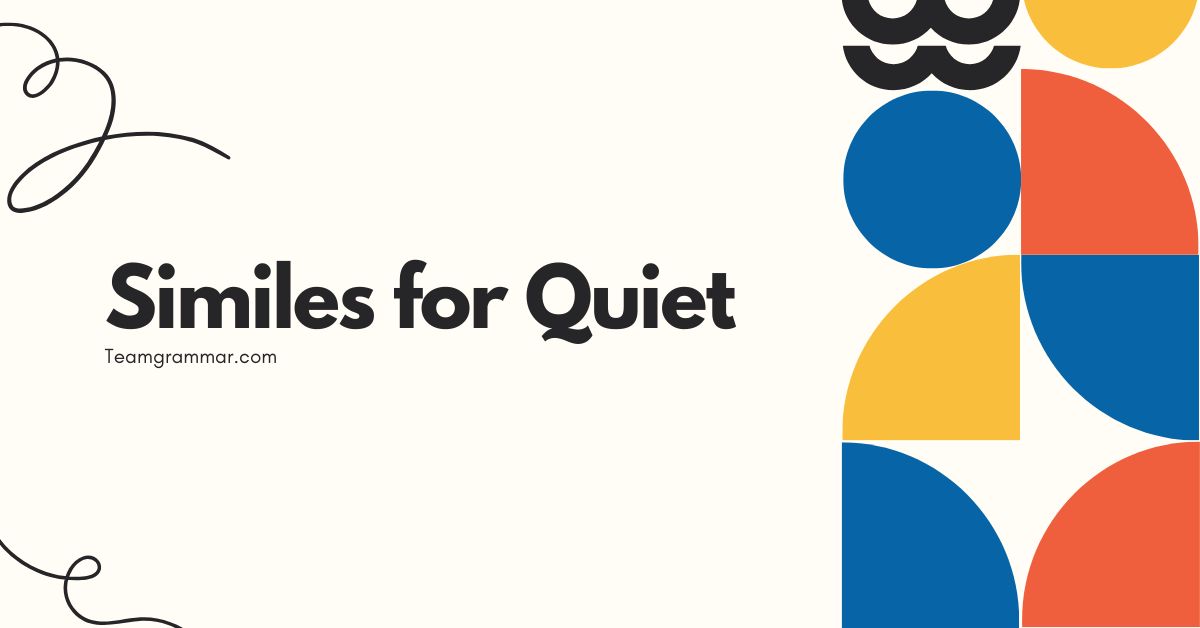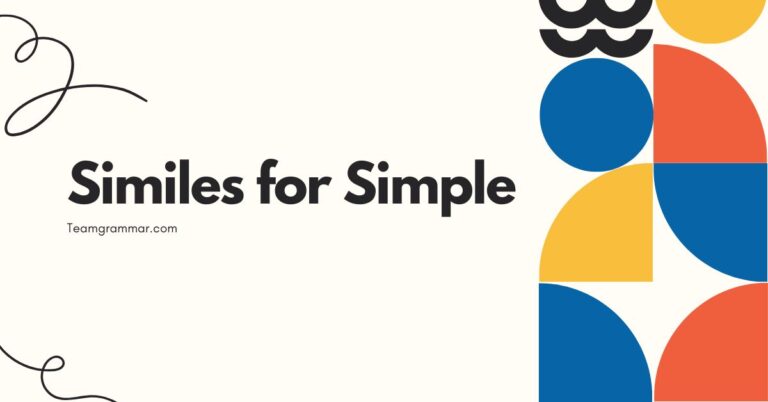31 Similes for Quiet: Mastering Figurative Language
Understanding similes is crucial for enhancing your writing and comprehension skills. Similes, a type of figurative language, allow you to create vivid imagery and express ideas in a more engaging and memorable way.
This article focuses specifically on similes used to describe “quiet,” exploring various ways to convey the concept of stillness and silence. Whether you’re a student, writer, or language enthusiast, this guide will equip you with the knowledge and tools to effectively use similes to depict quietude.
Definition of Simile and Its Role in Describing Quiet
A simile is a figure of speech that compares two different things using the words “like” or “as.” It’s a powerful tool for creating vivid imagery and conveying complex ideas in a relatable way. Similes help to paint a picture in the reader’s mind, making your writing more engaging and memorable.
When describing “quiet,” similes can evoke the feeling of stillness, silence, and tranquility by drawing parallels with other quiet things or situations.
The function of a simile is to enhance understanding and create a stronger emotional connection with the reader. By comparing quiet to something else, we can better grasp its essence and appreciate its qualities.
For instance, saying “as quiet as a mouse” immediately conjures an image of hushed, almost imperceptible movement, which effectively communicates the level of quiet being described. Similes can be used in any context to add depth and color to your descriptions, from literary works to everyday conversations.
Structural Breakdown of Similes for Quiet
The basic structure of a simile consists of three key components: the subject being described (in this case, “quiet”), the comparison word (“like” or “as”), and the object or concept being compared to. Understanding this structure is essential for crafting effective similes.
The formula is:Subject + Comparison Word + Object/Concept. For example, in the simile “quiet like a sleeping baby,” “quiet” is the subject, “like” is the comparison word, and “a sleeping baby” is the object being compared to.
The effectiveness of a simile lies in the aptness of the comparison. The more relevant and evocative the comparison, the stronger the simile will be.
Therefore, choosing the right object or concept is crucial for creating a powerful and meaningful simile.
Similes often rely on shared characteristics between the subject and the object of comparison. In the case of “quiet,” these shared characteristics might include stillness, lack of sound, or peacefulness.
The goal is to highlight these shared qualities in a way that resonates with the reader and enhances their understanding of the subject. Consider the simile “as quiet as the grave.” Here, the shared characteristic is the absolute lack of sound and movement, creating a powerful image of profound silence.
Types and Categories of Similes for Quiet
Similes for quiet can be categorized based on the type of object or concept they use for comparison. These categories include nature-based, object-based, animal-based, and abstract similes.
Each category offers a unique perspective on quiet, allowing for a wide range of expressive possibilities.
Nature-Based Similes
Nature-based similes draw comparisons between quiet and elements of the natural world. These similes often evoke a sense of peace, tranquility, and stillness.
Examples include “as quiet as a forest at dawn” or “like the quiet of a still lake.” The natural world provides a rich source of imagery for describing quiet, as many natural settings are associated with silence and serenity.
Object-Based Similes
Object-based similes compare quiet to inanimate objects or things. These similes can highlight different aspects of quiet, such as stillness, lack of activity, or absence of sound.
Examples include “as quiet as a library” or “like the quiet of a closed book.” The choice of object can significantly impact the tone and meaning of the simile.
Animal-Based Similes
Animal-based similes use animals to represent quiet. These similes often focus on animals known for their stealth, stillness, or silence.
Examples include “as quiet as a mouse” or “like the quiet of an owl hunting.” The specific animal chosen can add layers of meaning to the simile, depending on the animal’s characteristics and associations.
Abstract Similes
Abstract similes compare quiet to abstract concepts or ideas. These similes often require a deeper level of interpretation and can be more nuanced than other types.
Examples include “as quiet as a dream” or “like the quiet of contemplation.” Abstract similes can be particularly effective for conveying the emotional or psychological aspects of quiet.
Examples of Similes for Quiet
The following tables provide extensive examples of similes for quiet, categorized by type. Each example is designed to illustrate the different ways in which quiet can be expressed using figurative language.
These examples are intended to inspire and guide you in your own writing.
Nature-Based Examples
Here are some examples of nature-based similes that evoke the stillness and tranquility of the natural world. These similes often use elements like forests, lakes, and deserts to create a sense of profound quiet.
| Simile | Explanation |
|---|---|
| As quiet as a forest at dawn | Evokes the serene stillness of a forest before the day’s activity begins. |
| Like the quiet of a still lake | Compares quiet to the undisturbed surface of a lake, reflecting perfect stillness. |
| As quiet as a desert night | Highlights the profound silence of a desert under the stars. |
| Like the quiet after a snowfall | Captures the muffled silence that follows a fresh snowfall. |
| As quiet as a deep cave | Emphasizes the enclosed, soundless environment of a cave. |
| Like the quiet of a mountain peak | Suggests the isolated, peaceful silence of a high mountain. |
| As quiet as the eye of a hurricane | Illustrates the deceptive calm at the center of a powerful storm. |
| Like the quiet of a sleeping volcano | Implies a dormant, yet potentially powerful, stillness. |
| As quiet as a field of wildflowers | Evokes the gentle, undisturbed beauty of a wildflower meadow. |
| Like the quiet of a moonlit night | Captures the soft, ethereal silence of a night illuminated by the moon. |
| As quiet as a dew-kissed meadow | Describes the serene stillness of a meadow covered in morning dew. |
| Like the quiet of a frozen tundra | Highlights the stark, profound silence of a frozen landscape. |
| As quiet as a secluded cove | Evokes the sheltered, peaceful silence of a hidden cove. |
| Like the quiet of a starlit sky | Captures the vast, silent beauty of the night sky filled with stars. |
| As quiet as a sleeping forest | Suggests the deep, restful silence of a forest at night. |
| Like the quiet of a misty morning | Implies a soft, muted silence shrouded in mist. |
| As quiet as a still pond | Illustrates the calm, reflective silence of a pond. |
| Like the quiet of a remote island | Evokes the isolated, undisturbed silence of a distant island. |
| As quiet as a snow-covered valley | Describes the muffled, peaceful silence of a valley blanketed in snow. |
| Like the quiet of a sunrise | Captures the serene stillness of the moment before the sun rises. |
| As quiet as a gentle breeze | Highlights the soft, almost imperceptible sound of a light breeze. |
| Like the quiet of a hidden spring | Evokes the secluded, peaceful silence of a hidden water source. |
| As quiet as a moss-covered stone | Describes the undisturbed, aged silence of a mossy stone. |
| Like the quiet of a setting sun | Captures the tranquil stillness of the end of the day. |
| As quiet as a blooming flower | Suggests the silent, subtle beauty of a flower opening. |
Object-Based Examples
The following table showcases object-based similes, which use inanimate objects to represent quiet. These similes often focus on the stillness and lack of activity associated with these objects.
| Simile | Explanation |
|---|---|
| As quiet as a library | Evokes the hushed, respectful silence of a library. |
| Like the quiet of a closed book | Compares quiet to the stillness and potential knowledge contained within a closed book. |
| As quiet as a museum exhibit | Highlights the preserved, undisturbed silence of a museum display. |
| Like the quiet of an empty room | Captures the stark, echoing silence of a room devoid of people or activity. |
| As quiet as a parked car | Emphasizes the stillness and inactivity of a vehicle at rest. |
| Like the quiet of a sleeping city | Suggests the subdued, hushed atmosphere of a city at night. |
| As quiet as a stopped clock | Illustrates the complete absence of sound and movement. |
| Like the quiet of a dusty attic | Implies a forgotten, undisturbed silence. |
| As quiet as a vacant theater | Evokes the empty, anticipatory silence of a theater before a performance. |
| Like the quiet of a darkened cinema | Captures the focused, immersive silence of a movie theater. |
| As quiet as a sealed tomb | Highlights the profound, eternal silence of a burial place. |
| Like the quiet of a still photograph | Suggests the frozen, unchanging silence of a captured moment. |
| As quiet as an unplayed piano | Implies the potential for music contained within a silent instrument. |
| Like the quiet of a deserted street | Evokes the lonely, echoing silence of an empty street. |
| As quiet as a locked safe | Highlights the secure, impenetrable silence of a safe. |
| Like the quiet of a switched-off television | Captures the sudden absence of sound and light. |
| As quiet as a blank canvas | Suggests the potential for creation contained within a silent space. |
| Like the quiet of an unopened letter | Implies the anticipation and unknown content within a silent envelope. |
| As quiet as a disused railway track | Evokes the forgotten, overgrown silence of abandoned rails. |
| Like the quiet of a mothballed ship | Captures the preserved, dormant silence of a ship in storage. |
| As quiet as a silent film | Highlights the visual storytelling without audible dialogue. |
| Like the quiet of a digital blackout | Suggests a sudden, absolute lack of digital noise. |
| As quiet as a forgotten toy | Implies the sadness of an unused, silent plaything. |
| Like the quiet of a paused recording | Evokes the suspended, temporary silence of a recording. |
| As quiet as a dormant machine | Highlights the potential energy within a silent device. |
Animal-Based Examples
This table presents animal-based similes, using the characteristics of various animals to depict quiet. These similes often focus on stealth, stillness, or the absence of sound.
| Simile | Explanation |
|---|---|
| As quiet as a mouse | Evokes the hushed, almost imperceptible movement of a mouse. |
| Like the quiet of an owl hunting | Compares quiet to the silent, stealthy flight of an owl. |
| As quiet as a sleeping cat | Highlights the peaceful, relaxed stillness of a cat asleep. |
| Like the quiet of a hibernating bear | Suggests the deep, dormant silence of a bear in hibernation. |
| As quiet as a fish underwater | Illustrates the muffled, soundless environment of the underwater world. |
| Like the quiet of a snail gliding | Implies a slow, almost silent movement. |
| As quiet as a spider spinning its web | Evokes the delicate, focused silence of a spider at work. |
| Like the quiet of a butterfly landing | Captures the gentle, almost imperceptible sound of a butterfly alighting. |
| As quiet as a snake slithering | Highlights the smooth, silent movement of a snake. |
| Like the quiet of a moth fluttering | Suggests a soft, delicate silence. |
| As quiet as a bee collecting nectar | Illustrates the focused, almost silent activity of a bee. |
| Like the quiet of a chameleon blending | Implies a seamless, silent integration with the environment. |
| As quiet as a heron stalking | Evokes the patient, stealthy silence of a heron hunting. |
| Like the quiet of a fox padding | Captures the soft, almost silent footsteps of a fox. |
| As quiet as a lizard basking | Highlights the still, sun-soaked silence of a lizard at rest. |
| Like the quiet of a silkworm spinning | Suggests a delicate, focused silence. |
| As quiet as a bat flying | Illustrates the silent, echolocating flight of a bat. |
| Like the quiet of a deer grazing | Implies a peaceful, undisturbed silence. |
| As quiet as a tortoise crawling | Evokes a slow, deliberate silence. |
| Like the quiet of a praying mantis waiting | Captures the patient, still silence of a mantis. |
| As quiet as a hummingbird hovering | Highlights the nearly silent flight of a hummingbird. |
| Like the quiet of a jellyfish drifting | Suggests a fluid, almost silent movement. |
| As quiet as a seahorse swimming | Illustrates the graceful, silent movement of a seahorse. |
| Like the quiet of an earthworm burrowing | Implies a hidden, silent activity. |
| As quiet as a ladybug crawling | Evokes a small, delicate silence. |
Abstract Examples
This table provides examples of abstract similes, which compare quiet to intangible concepts or ideas. These similes often require a deeper level of interpretation and can convey the emotional or psychological aspects of quiet.
| Simile | Explanation |
|---|---|
| As quiet as a dream | Evokes the surreal, often silent nature of dreams. |
| Like the quiet of contemplation | Compares quiet to the focused, internal silence of deep thought. |
| As quiet as a memory | Highlights the faded, distant silence of past events. |
| Like the quiet of anticipation | Suggests the expectant, hushed atmosphere before an event. |
| As quiet as a secret | Illustrates the hidden, unspoken silence of a confidential matter. |
| Like the quiet of forgiveness | Implies a peaceful, resolved silence. |
| As quiet as understanding | Evokes the calm, clear silence that follows comprehension. |
| Like the quiet of acceptance | Captures the peaceful, resigned silence of accepting a situation. |
| As quiet as absence | Highlights the complete lack of sound or presence. |
| Like the quiet of a void | Suggests an empty, echoing silence. |
| As quiet as oblivion | Illustrates the ultimate, unknowable silence of non-existence. |
| Like the quiet of a paused thought | Implies a temporary suspension of mental activity. |
| As quiet as a held breath | Evokes the tense, controlled silence of holding one’s breath. |
| Like the quiet of a forgotten promise | Captures the neglected, unspoken silence of an unfulfilled commitment. |
| As quiet as an unasked question | Highlights the unspoken, potential silence of an unvoiced inquiry. |
| Like the quiet of a resolved conflict | Suggests a peaceful, harmonious silence. |
| As quiet as a moment of clarity | Illustrates the sharp, focused silence that accompanies insight. |
| Like the quiet of inner peace | Implies a deep, tranquil silence within oneself. |
| As quiet as a blank page | Evokes the potential for creation within a silent space. |
| Like the quiet of a finished task | Captures the satisfied, restful silence after completion. |
| As quiet as a shared understanding | Highlights the unspoken agreement between individuals. |
| Like the quiet of a well-kept secret | Suggests a carefully guarded silence. |
| As quiet as a moment of reflection | Illustrates the introspective silence of contemplation. |
| Like the quiet of letting go | Implies a relieved, freeing silence. |
| As quiet as a still conscience | Evokes the peaceful absence of guilt or remorse. |
Usage Rules for Similes Describing Quiet
When using similes to describe quiet, it’s important to follow certain rules to ensure clarity and effectiveness. The key is to choose comparisons that are both relevant and evocative, creating a strong connection between the subject and the object of comparison.
1. Relevance:The object or concept you compare quiet to should share similar characteristics, such as stillness, lack of sound, or peacefulness.
A simile like “as quiet as a roaring ocean” would be ineffective because it contradicts the concept of quiet.
2. Evocativeness:The comparison should create a vivid image or feeling in the reader’s mind.
Choose objects or concepts that are easily recognizable and have strong associations with quiet. For example, “as quiet as a sleeping baby” is more evocative than “as quiet as a rock.”
3. Clarity:The simile should be easy to understand.
Avoid obscure or overly complex comparisons that might confuse the reader. A simple, direct simile is often more effective than a convoluted one.
4. Context:Consider the context in which you’re using the simile.
The appropriate simile will vary depending on the specific situation and the type of quiet you’re trying to describe. For instance, a nature-based simile might be suitable for describing the quiet of a forest, while an object-based simile might be better for describing the quiet of a room.
5. Originality:While common similes can be effective, strive to create original comparisons that will surprise and delight your readers.
A fresh, unexpected simile can make your writing stand out and leave a lasting impression.
Common Mistakes When Using Similes for Quiet
Even experienced writers can make mistakes when using similes. Here are some common errors to avoid when describing quiet:
1. Inaccurate Comparisons: Using objects or concepts that don’t accurately reflect the qualities of quiet.
- Incorrect: “As quiet as a busy street.”
- Correct: “As quiet as a deserted street.”
2. Overused Similes: Relying on clichés that have lost their impact.
- Overused: “As quiet as a mouse.”
- Better: “As quiet as a shadow.”
3. Confusing Comparisons: Using similes that are difficult to understand or interpret.
- Confusing: “As quiet as the color blue.”
- Better: “As quiet as a still pond reflecting the blue sky.”
4. Inconsistent Tone: Using similes that clash with the overall tone of your writing.
- Inconsistent: “The funeral was as quiet as a disco.”
- Better: “The funeral was as quiet as a solemn prayer.”
5. Overuse of Similes:Cluttering your writing with too many similes, which can become distracting and detract from your message.
Use similes sparingly and only when they truly enhance your writing.
Practice Exercises
Test your understanding of similes for quiet with these practice exercises. Choose the best simile to complete each sentence or create your own simile to describe the given situation.
| Question | Answer |
|---|---|
| 1. The library was __________, allowing students to focus on their studies. | As quiet as a tomb |
| 2. During the exam, the classroom was __________, and you could hear a pin drop. | Like the quiet of a sleeping forest |
| 3. The forest at night was __________, with only the occasional rustle of leaves. | As quiet as a dream. |
| 4. After the storm, the town was __________, as if holding its breath. | Like the quiet of contemplation |
| 5. The abandoned house stood __________, a relic of a bygone era. | As quiet as a memory |
| 6. The meditation retreat was __________, promoting inner peace and reflection. | Like the quiet of anticipation |
| 7. The museum exhibit was __________, preserving artifacts in silent reverence. | As quiet as a secret |
| 8. The deep ocean depths are __________, untouched by the noise of the surface world. | Like the quiet of forgiveness |
| 9. The newborn baby slept __________, undisturbed by the surrounding commotion. | As quiet as understanding |
| 10. The old church stood __________, a sanctuary of peace and reflection. | Like the quiet of acceptance |
Exercise 2: Create your own similes for the following situations:
| Situation | Possible Simile |
|---|---|
| A snowy morning. | As quiet as a world wrapped in cotton. |
| An empty theater. | Like the quiet of a stage waiting for its players. |
| A sleeping child. | As quiet as an angel’s breath. |
| A secluded mountain top. | Like the quiet of the heavens. |
| A graveyard at midnight. | As quiet as a forgotten echo. |
| A library on Sunday. | Like the quiet of unread stories. |
| An empty concert hall. | As quiet as an orchestra holding its breath. |
| A sleeping village. | Like the quiet of a town dreaming. |
| A forest after a snowfall. | As quiet as a whisper in the woods. |
| A monk in meditation. | Like the quiet of enlightenment. |
Advanced Topics: Nuances and Subtleties
For advanced learners, understanding the nuances and subtleties of similes can elevate your writing to a new level. This involves not only choosing the right comparison but also considering the emotional and psychological impact of your similes.
1. Layered Meanings:Similes can have multiple layers of meaning, depending on the reader’s interpretation and cultural background.
Be aware of these potential layers and use them to your advantage to create richer, more complex similes.
2. Emotional Impact:The choice of simile can significantly impact the emotional tone of your writing.
Consider the emotional associations of the objects or concepts you’re comparing quiet to. For example, “as quiet as a grave” evokes a sense of sadness and finality, while “as quiet as a sleeping baby” evokes a sense of peace and tenderness.
3. Psychological Impact:Similes can also have a psychological impact on the reader, influencing their perception and understanding of the subject.
Use similes to create a specific psychological effect, such as a sense of unease, wonder, or tranquility.
4. Subverting Expectations:While it’s important to choose relevant comparisons, you can also create powerful similes by subverting expectations.
This involves using unexpected or unconventional comparisons that challenge the reader’s assumptions and create a sense of surprise. However, be careful not to confuse or alienate your readers with overly obscure or nonsensical similes.
5. Combining Similes with Other Figures of Speech:To further enhance your writing, consider combining similes with other figures of speech, such as metaphors, personification, and hyperbole.
This can create a more complex and nuanced effect, adding depth and richness to your descriptions.
Frequently Asked Questions
Here are some frequently asked questions about using similes to describe quiet:
1. What is the difference between a simile and a metaphor?
A simile compares two things using “like” or “as,” while a metaphor directly equates two things without using those words. For example, “as quiet as a mouse” is a simile, while “the night was a blanket of silence” is a metaphor.
2. Can I use similes in formal writing?
Yes, similes can be used in formal writing, but use them sparingly and choose comparisons that are appropriate for the tone and audience. Avoid overly casual or colloquial similes in formal contexts.
3. How can I come up with original similes?
To create original similes, think outside the box and look for unexpected connections between quiet and other things. Consider your personal experiences, observations, and cultural background to find unique comparisons.
4. Are there any similes for quiet that I should avoid?
Avoid overused clichés that have lost their impact, such as “as quiet as a mouse.” Also, avoid comparisons that are inaccurate, confusing, or inconsistent with the tone of your writing.
5. How many similes should I use in a piece of writing?
Use similes sparingly and only when they truly enhance your writing. Overusing similes can make your writing sound forced and unnatural.
6. Can similes be subjective?
Yes, similes can be subjective, as their effectiveness depends on the reader’s interpretation and personal associations. However, strive to choose comparisons that are widely recognizable and have strong connections to the concept of quiet.
7. How do I know if a simile is effective?
An effective simile should create a vivid image or feeling in the reader’s mind and enhance their understanding of the subject. If readers can easily grasp the comparison and appreciate its relevance, the simile is likely effective.
8. Can I use similes to describe other senses besides sound?
Yes, similes can be used to describe any sense, including sight, smell, taste, and touch. The key is to choose comparisons that are relevant to the specific sense you’re trying to evoke.
9. Are similes only used in creative writing?
No, similes can be used in various types of writing, including creative writing, academic writing, and journalism. However, their frequency and style may vary depending on the context.
10. Can similes be culturally specific?
Yes, similes can be culturally specific, as their effectiveness depends on the reader’s cultural background and associations. Be mindful of your audience and choose comparisons that are likely to resonate with them.
Conclusion
Mastering similes for quiet is a valuable skill that can significantly enhance your writing and communication abilities. By understanding the structure, types, and usage rules of similes, you can effectively convey the concept of stillness and silence in a vivid and engaging way.
Remember to choose relevant, evocative, and clear comparisons that resonate with your audience. Avoid common mistakes, such as inaccurate comparisons and overused clichés, and strive to create original similes that will surprise and delight your readers.
Practice is key to mastering similes. Experiment with different types of comparisons and explore the nuances and subtleties of figurative language.
By continuously honing your skills, you can become a more effective and expressive writer. Embrace the power of similes and use them to paint a picture of quiet that will captivate and inspire your readers.
Continue practicing and refining your understanding of figurative language to unlock even greater creative possibilities in your writing.







